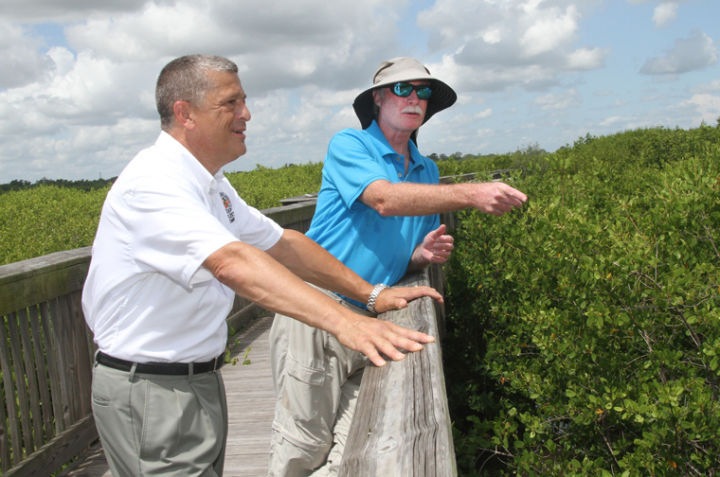INDIAN RIVER COUNTY — County Commission Chairman Joe Flescher today proposed sending a letter to Indian River County cities asking them to consider adopting fertilizer ordinances that match the strong progressive legislation passed by the county on Aug. 20.
The letter is timely because the cities of Sebastian, Vero Beach and Indian River shores all have the matter on their agendas for consideration within the next three weeks. All three cities already have the state model fertilizer ordinance on their books, but that set of regulations is now regarded as too vague, ineffective and difficult to enforce.
Sebastian will consider the matter first, at tomorrow night’s city council meeting. Councilmember Andrea Coy, a leader on environmental issues who put the matter on the agenda, is cautiously optimistic about the outcome.
“I have learned not to speak for my council, but it feels like the time is right,” she says. “The county finally stepped up to the plate and wrote a good ordinance and we should all be on the same page.”
Sebastian Vice-Mayor Don Wright says he is in favor of the stronger ordinance as long as it is allowed by state law, and council observers believe there is a third vote to provide a majority for change.
Coy says members of the city’s natural resources board, which has not officially ruled on the question, will be at the city council meeting as individuals to support an effective fertilizer ordinance that matches county regulations.
Vero Beach City Council will consider and vote of on the question at its Oct. 1 meeting and prospects for passage of a strong Sarasota-style ordinance seem high.
Councilmembers Dick Winger and Pilar Turner went on record in favor of stronger regulation at the Sept. 9 city council meeting when the matter was slated for the Oct. 1 agenda.
“The general feeling seemed to be that the city should probably modify or repeal our existing ordinance,” Winger said after the meeting.
Indian River Shores Vice-Mayor Gerard Weick raised the question of modifying the Shores’ fertilizer ordinance to match the county’s at the August town council meeting.
The matter is now on the town council’s Sept. 25 agenda as a discussion item that can be voted on and Weick says he would like to see the change made.
“We can’t have ten different [fertilizer regulation] programs running around,” Weick says. “The best thing to do is exactly duplicate the county ordinance.”
The county ordinance adds to the state rules a ban on phosphorous and a four-month rainy-season blackout period that prohibits application of nitrogen from the beginning of June through the end of September, when heavy downpours are more likely to wash fertilizer into the lagoon.
It also mandates use of nitrogen that is at least 50-percent slow-release to reduce the amount of chemicals leeching into groundwater, prohibits application of fertilizer within 10 feet of waterways, and requires lawn-care professionals who apply fertilizer to take a state-regulated training course and be licensed.
Bob Bruce, vice president of Pelican Island Audubon Society, and Indian River Neighborhood Association Executive Director Dan Lamson spoke in support of the letter and the idea of IRC cities adopting county-like ordinances to help protect the Indian River Lagoon from poisonous chemicals that are destroying the estuary’s ecology.
After some discussion of the wording the letter, the commission voted unanimously to support Flescher’s initiative. Flescher and County Attorney Dylan Reingold promised the letter would go out in time to reach the Sebastian City Council ahead of their Wednesday evening meeting.
“We finally have the attention of the politicians and the momentum is there to pass strong regulations to protect the lagoon,” Coy says.

